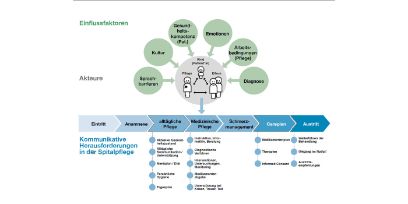- Story
Six ways in which design can improve safety
21.03.2023 Overflowing patient information leaflets, communication difficulties, impossible-to-find examination rooms, a frightening hospital atmosphere: six practical examples show how research-based design can positively influence hospital stays.
If the font is too small, the sign incomprehensible or the furniture not ergonomic, this can have fatal consequences in a hospital environment. Research-based design therefore looks for ways to communicate clearly, design safely, optimise what already exists, improve orientation, strengthen feelings of safety and reduce uncertainty.
1 Communicating clearly
In the health sector, the unambiguous communication of information is essential. Inadequate or misunderstood information can quickly lead to uncertainty, poor compliance or incorrect care in everyday practice.
2 Designing safe healthcare buildings
When planning healthcare buildings, safety-related design aspects should be examined as early as possible for both healthcare users and healthcare staff. This helps to avoid mistakes, minimise safety risks and reduce costs.
About us
Since 2007, an interdisciplinary team at Bern University of Applied Sciences has been researching questions relating to design and health. Experts from the fields of design, architecture, nursing, medical informatics and business collaborate with healthcare institutions. Since 2022, the team has been conducting research at the Swiss Center for Design and Health (SCDH), a public-private partnership in which Bern University of Applied Sciences is also involved. The SCDH combines interdisciplinary university research and the private sector with a focus on knowledge and technology transfer.
3 Optimising existing buildings
Existing buildings can be optimised, too. For example, an interdisciplinary team of BFH researchers makes concrete suggestions for improvements in terms of safety, ergonomics and hygiene.
4 Communicating safety
The design of the spatial environment helps older patients and patients with cognitive impairments to orientate themselves better and to feel safe and comfortable during their stay.
5 Reducing uncertainty
Poor signage misdirects people, leaving them disorientated and unsettled. Holistic, evidence-based and human-centred design concepts can counteract this. One example is the Sollievo.net Centre for Mental Health, which provides care for people with mental illnesses.
6 Ensuring orientation
The interior design of the Felix Platter University for Geriatric Medicine in Basel needed to be improved. Thanks to a newly developed signage, colour and image concept, both healthcare users and staff should be able to find their way around the hospital more easily.
The examples discussed are from projects of an interdisciplinary research team at Bern University of Applied Sciences and the Swiss Center for Design and Health (SCDH), the national technology competence centre at the interface of design and health based in Nidau, Biel/Bienne.

















